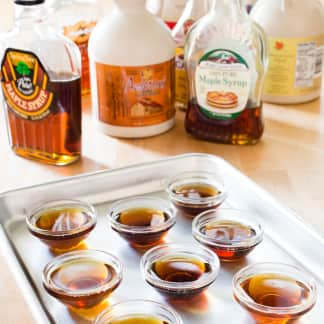Waffle makers for home cooks come in two main styles: classic machines that make shorter waffles with shallow indents, and Belgian-style machines that make thick waffles with bigger indents. Regardless of style, the best models are easy and safe to use and produce golden, evenly-browned waffles.
Our winning Belgian-style waffle maker is the Breville Smart Waffle 4 Slice. It is easy to use, has audible and visual alerts, and makes gorgeous thick waffles.
The Presto FlipSide Belgian Waffle Maker is our Best Buy, and it makes golden Belgian waffles that are even thicker than our winner’s. It sometimes drips hot condensation when flipped, so it requires a little extra caution when using.
For those who prefer thinner waffles, our winning classic waffle maker is the Breville No-Mess Waffle Maker. While the waffles it made are on the thicker side for a classic style, they were evenly browned and perfectly crisp.

Waffles are usually a weekend morning treat—a step up from pancakes but a little more hands-off than French toast. Unlike either of those breakfast items, you need a dedicated waffle iron to make them. Electric waffle irons are the easiest to use; good models are essentially plug-and-play. Most models have a power button and a dial to select the darkness or crispness you want your waffle cooked to. Some also have additional settings for various types of waffles. Select your setting; pour in your batter; and a few minutes later, you have a golden, crisp waffle.

There are two main types of waffle irons. Classic waffle irons make thinner waffles that measure less than an inch in height and have shallower indents. They’ve decreased in popularity somewhat over the years, however, so there are fewer on the market. Belgian waffle irons are now more widely available; they make taller waffles that measure at least an inch in height and have deeper indents.


Flip- and rotary-style waffle makers (right) turn on a hinge or spins 180 degrees on a stand during use. By contrast, stationary models (left) simply open and close on a hinge.
Belgian waffle irons can work in two different ways. With flip- and rotary-style models, the machine either turns on a hinge or spins 180 degrees on a stand. By contrast, stationary models simply open and close on a hinge.
What to Look For
- Even Browning: We liked waffle makers that made waffles that were evenly golden from edge to edge.

- Medium-High Temperatures: For insight into why some models performed better than others, we attached temperature probes to the irons’ interiors to analyze their heating cycles. The best irons maintained an average interior temperature between 400 and 435 degrees Fahrenheit at their recommended settings, making waffles that were crisp on the outside and moist on the inside.
- Moderately Speedy Cooking: Our recommended irons were able to regularly produce perfectly cooked waffles in 3 to 4½ minutes, ensuring that they crisped enough on the outside without drying out too much.
- Audible and/or Visual Alerts: We preferred machines with audible and/or visual alerts that told us when our waffles were ready, which nixed the need for constant monitoring.
- Safe Operation: We liked machines that felt safe and comfortable to use. We preferred those that maintained cool handles and didn’t drip hot condensation as waffles cooked.
- Simple Interface: Models that had straightforward control panels with an on/off button and a dial for doneness made it a breeze to cook waffles to our preferences.

Nice to Have
- A Drip Tray or Moat: Some machines had a drip tray or moat that contained crumbs and overflowing batter for quick cleanup. Some of the moats cooked this overflow to cut down on waste, although these bits were often very pale since they were at the very edge of the machine.

What to Avoid
- Uneven Browning: Very few of the irons were able to make waffles that were uniformly brown. Most were darker toward the center and pale at the edges.

- Low or High Temperatures: Waffle makers that couldn’t get up to 400 degrees turned out pale, floppy specimens no matter how long we let the waffles cook, while those that ran hotter than 435 degrees frequently overcooked their waffles, which resulted in a cardboard-like texture.
- Cooking Too Fast or Too Slow: Several models that functioned within the ideal temperature range still failed to make good waffles in a moderate period of time. Some irons quickly signaled that the waffle was done, yet produced spongy, undercooked specimens. Others took too long and turned out leathery, stale-tasting waffles.
- No Alerts: Some machines had no audible or visual alerts to signal when the waffles were done, requiring us to open the iron periodically to check. These machines required constant monitoring, letting heat escape and therefore taking longer to cook.
- Complicated Interfaces: Some waffle makers had upwards of five settings for buttermilk, berries, chocolate, and more. We preferred models that relied on a simple power button and a dial for doneness, letting us customize waffles to our liking no matter the type.

Other Considerations
- Rotary and Flip Models versus Stationary Models: Rotary and flip-style waffle irons claim to produce more evenly browned waffles than simple stationary models. In theory, flipping or rotating the waffle ensures that both sides make full contact with a hot plate. But in practice, we found that the construction style had very little to do with how well an iron browned its waffles. Our favorite Belgian waffle iron is a stationary model; our Best Buy, a flip-style one. Both make perfectly browned waffles. Other factors, including the way the heating element is configured and the heat retention of the plates themselves, are ultimately more important.
The Tests
- Make Buttermilk Waffles plain and with mix-ins (chocolate chips, blueberries)
- Make Yeasted Waffles
- Evaluate heat output at different settings using temperature probes
How We Rated
- Performance: We rated the machines on how well and evenly they made waffles.
- Ease of Use: We rated the machines on how easy it was to operate them.
- Safety: We evaluated the machines on any safety hazards they created.

































